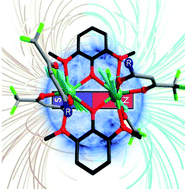Complementation and joint contribution of appropriate intramolecular coupling and local ion symmetry to improve magnetic relaxation in a series of dinuclear Dy2 single-molecule magnets†
Abstract
A series of lanthanide binuclear complexes with formula [Dy2(DMOP)2(NTFA)4] (1), [Dy2(DMOP)2(NTFA)4(CH3OH)2·2H2O] (1a), [Dy2(DMOP)2(BTFA)4] (2), [Dy2(DMOP)2(TTA)4] (3), [Y2(DMOP)2(TTA)4] (3Y), [Tb2(DMOP)2(NTFA)4] (4), [Tb2(DMOP)2(NTFA)4(CH3OH)2·2H2O] (4a), [Er2(DMOP)2(NTFA)4] (5), [Gd2(DMOP)2(NTFA)4(CH3OH)2·2H2O] (6), and [Gd2(DMOP)2(TTA)4] (7) (DMOP = 2,6-dimethoxyphen, NTFA = 2-naphtoyltrifluoroacetone, BTFA = benzoyltrifluoroacetone, TTA = thenoyltrifluoroacetone) have been structurally and magnetically characterized. They possess nearly the same dinuclear Ln2 cores bridged by double μ2-phenoxyl oxygen atoms and differ in the peripheral coordinated β-diketonate ligands or coordinated neutral MeOH molecule. The Dy(III)-based derivatives show significant zero-field single-molecule magnet behavior. It is noteworthy that the single-molecule magnet (SMM) performance of 1 was dramatically improved after transforming to 1a with a nearly double energy barrier, which is mostly due to the enhancement of local symmetry around Dy(III) ions in 1a by the introduction of a CH3OH molecule. In addition, the nature of intramolecular Dy–Dy interaction changed from antiferromagnetic to ferromagnetic coupling. The detailed ab initio calculation reveals the alternate domination of the intramolecular exchange coupling and dipole–dipole interactions in 1 and 1a, respectively. Furthermore, improved SMM performance with a hysteresis temperature of 3 K was observed in diluted samples of 3. In the present work, the joint contribution of intramolecular coupling and local symmetry to improve their dynamic magnetic relaxation was unambiguously affirmed.



 Please wait while we load your content...
Please wait while we load your content...